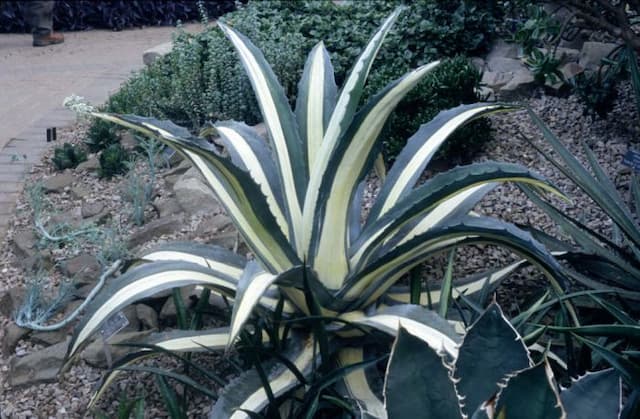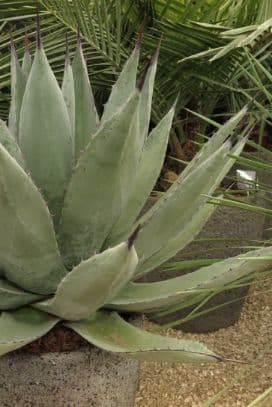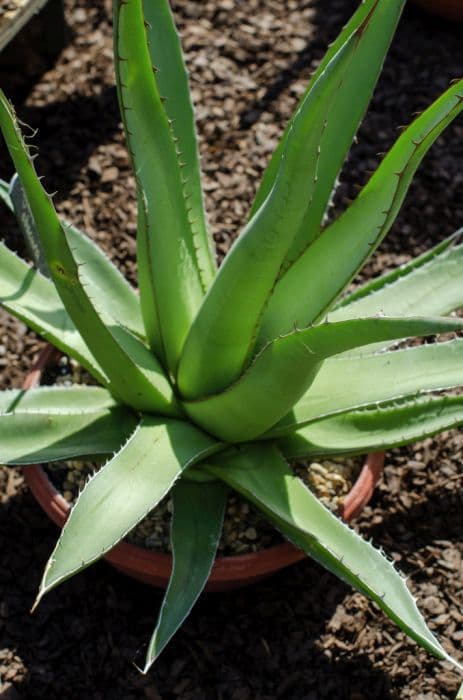Hosta Hosta 'Wheee!' (Shadowlands Series)

ABOUT
The Hosta 'Wheee!' is a visually striking plant, known for its unique foliage and texture. This member of the Shadowlands Series boasts leaves that are incredibly ornate and showy. Each leaf has a wavy, ruffled edge, giving it a frilly appearance that is quite dramatic and unconventional when compared to other more typically smooth-leaved hosta varieties. The leaves themselves are a vibrant green with prominent creamy-white to light yellow margins that lend a lovely contrast. This variegation can create a bright effect in shadier garden spots. A closer examination of the leaves reveals a deeply puckered surface, adding even more visual interest and texture. During the bloom period, the Hosta 'Wheee!' produces lavender flowers, which rise on slender stalks above the foliage, contrasting nicely with the variegated leaves and adding an extra layer of appeal to the plant. The overall impression is one of exuberance and motion, as suggested by the playful cultivar name 'Wheee!'. This hosta's unique characteristics truly set it apart in the landscape with its engaging appearance.
About this plant
 Names
NamesFamily
Asparagaceae
Synonyms
Plantain Lily, Funkia, Hosta
Common names
Hosta 'Wheee!' (Shadowlands Series)
 Characteristics
CharacteristicsLife cycle
Perennials
Foliage type
Deciduous
Color of leaves
Variegated
Flower color
Lavender
Height
1 foot 8 inches (50 cm)
Spread
2 feet (61 cm)
Plant type
Herb
Hardiness zones
3-9
Native area
Asia
Benefits
 General Benefits
General Benefits- Ornamental Appeal: Hosta 'Wheee!' has uniquely ruffled leaves and attractive foliage that adds visual interest to gardens.
- Shade Tolerance: This plant thrives in shaded areas where many other plants struggle, making it ideal for areas under trees or in the shadow of buildings.
- Low Maintenance: Hostas generally require minimal care once established, making them a convenient choice for gardeners of all skill levels.
- Seasonal Interest: Hosta 'Wheee!' undergoes a transformation throughout the growing season, with changes in leaf color and the emergence of flower stalks, providing extended visual appeal.
- Drought Tolerance: Once established, Hosta 'Wheee!' can tolerate periods of drought, making it suitable for areas with occasional water restrictions.
- Variety of Sizes: As a member of the Shadowlands Series, the 'Wheee!' variety comes in a size that can fit into a range of garden designs and spaces.
- Attracts Wildlife: The flowers of the Hosta 'Wheee!' can attract pollinators such as bees and hummingbirds, adding another layer of life to the garden.
- Companion Planting: Hostas can be planted alongside other shade-loving perennials to create a lush, layered garden bed.
- Cold Hardy: Hosta 'Wheee!' is capable of withstanding cold winters in many climates, making it a resilient addition to the garden.
- Garden Borders: Its distinctive foliage makes it a good choice for borders or as an accent plant in garden designs.
 Medical Properties
Medical PropertiesThis plant is not used for medical purposes.
 Air-purifying Qualities
Air-purifying QualitiesThis plant is not specifically known for air purifying qualities.
 Other Uses
Other Uses- Hosta leaves can be used for printing patterns in craft projects. By painting one side of the leave and pressing it onto paper or fabric, you can create natural designs.
- Hostas can be grown in water gardens or near ponds for decorative purposes, they thrive in damp conditions.
- The large leaves of the hosta can provide a natural shelter for small wildlife in your garden, like frogs or beneficial insects.
- Plants like Hosta 'Wheee!' can be used in a living mulch approach, where they cover the ground and suppress weeds while also adding aesthetic value.
- They can be used for edging in landscaping, providing a contrasting shape and color to linear features like pathways or borders.
- Floral artists use hosta leaves in arrangements to add volume and a lush, green backdrop to colorful flowers.
- In garden design, hosta's variety of leaf colors and textures can be used to create a tapestry effect in shade gardens.
- Hosta flowers attract pollinators and can be included in a “pollinator-friendly” garden to support bees, butterflies, and other beneficial insects.
- The hosta 'Wheee!' specifically, with its unique ruffled leaves, can be an interesting addition to children's gardens, offering sensory experiences.
- They can be planted around the base of trees where other plants may struggle to grow due to shade, providing a neat and attractive ground cover.
Interesting Facts
 Feng Shui
Feng ShuiThe Hosta is not used in Feng Shui practice.
 Zodiac Sign Compitability
Zodiac Sign CompitabilityThe Hosta is not used in astrology practice.
 Plant Symbolism
Plant Symbolism- Resilience: Hostas, in general, are known for their ability to thrive in a variety of climates and conditions, symbolizing one's ability to endure and adapt to life's challenges.
- Self-care: With their lush foliage and preference for shade, hostas remind us of the importance of seeking rest and comfort in our busy lives, much like how the plant seeks refuge from the harsh sun.
- Devotion: The way hostas return each year, growing more robust over time, signifies devotion and long-lasting relationships or commitments.
- Privacy: Due to their dense foliage, hostas can symbolize the idea of creating a private space or boundary, encouraging introspection and personal space.
 Water
WaterHostas require consistent moisture, particularly during their growing season in the spring and early summer. For Hosta 'Wheee!', water deeply once a week, providing about 1 gallon of water per plant. During periods of drought or extreme heat, you may need to water more frequently, ensuring the soil remains moist but not waterlogged. It is best to water early in the morning directly at the base of the plant to keep the leaves dry and prevent fungal diseases. Adjust watering based on rainfall, and in the fall, reduce the frequency as the plant prepares for dormancy.
 Light
LightThe Hosta 'Wheee!' prefers partial to full shade conditions. It thrives best in a spot that offers morning sunlight with protection from the harsh afternoon sun. An ideal location would be under the canopy of trees or on the north side of a building where it can receive filtered light throughout the day. Avoid placing it in direct, strong sunlight as it can scorch the foliage.
 Temperature
TemperatureHostas, including Hosta 'Wheee!', grow best in temperatures that range from 50°F to 75°F. They can survive short periods of colder weather, down to about 30°F, but frost can damage the leaves. During hot summer days when temperatures exceed 85°F, the plant might show signs of stress. To maintain optimal growth and health, provide adequate shade and water to keep it cool during heatwaves.
 Pruning
PruningPruning Hosta 'Wheee!' is mainly done to remove any dead or damaged leaves, which helps maintain the plant’s appearance and overall health. Prune away spent flower stalks after blooming to direct the plant’s energy back to the foliage. It’s best to prune in early spring or as needed throughout the growing season. Every few years, hostas may also benefit from being divided to rejuvenate the plant and control its size.
 Cleaning
CleaningAs needed
 Soil
SoilThe best soil mix for Hostas should be rich in organic matter, well-draining, and have a slightly acidic to neutral pH between 6 and 7. A good mix can be made from equal parts of garden soil, compost, and perlite or pine bark fines to ensure proper drainage and aeration.
 Repotting
RepottingHostas generally do not need to be repotted frequently as they can thrive in the same spot for several years. Hostas should be repotted or divided every 3 to 5 years to rejuvenate their growth and manage their size.
 Humidity & Misting
Humidity & MistingHostas prefer average to high humidity levels but are quite adaptable. Aim for a humidity level around 50-60% for optimal growth.
 Suitable locations
Suitable locationsIndoor
Provide bright, indirect light and keep soil consistently moist.
Outdoor
Plant in partial to full shade in moist, rich soil.
Hardiness zone
3-9 USDA
 Life cycle
Life cycleThe Hosta 'Wheee!' begins its life as a dormant bulb or rhizome, which breaks dormancy in the spring. It then enters a rapid vegetative growth phase, where its distinctive wavy leaves unfurl and expand to form a mounded clump. Throughout the summer, the Hosta 'Wheee!' grows larger and may produce flower stalks that rise above the foliage, blooming with lavender or white flowers that attract pollinators. After the blooming period, the plant's growth slows, and it prepares for dormancy. In the fall, the foliage begins to die back as the plant enters a dormant state to survive the winter. The cycle begins anew come spring, as the Hosta 'Wheee!' emerges from dormancy and starts its growth cycle again.
 Propogation
PropogationPropogation time
Late spring-early summer
The Hosta 'Wheee!', known commonly as Hosta or plantain lily, can be propagated in various ways, but division remains the most popular and practical method. This is usually best done in the spring as the new shoots, referred to as "eyes," start to emerge. To propagate by division, first dig up the hosta clump with a shovel, being careful to keep a generous amount of soil around the roots. Using a sharp knife or spade, split the clump into smaller sections, ensuring that each new division has at least 2-3 eyes. Once the divisions are made, replant each section at the same soil depth it was previously growing. Divisions should be spaced at least one foot (approximately 30 centimeters) apart to provide adequate room for growth. It is crucial to keep the new divisions well-watered until they are established.









